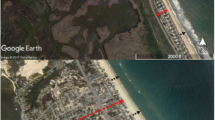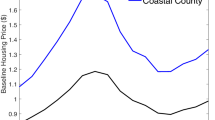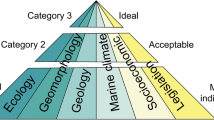Abstract
Climate change threatens to alter coastline erosion patterns in space and time and coastal communities adapt to these threats with decentralized shoreline stabilization measures. We model interactions between two neighboring towns, and explore welfare implications of spatial-dynamic feedbacks in the coastal zone. When communities are adjacent, the community with a wider beach loses sand to the community with a narrower beach through alongshore sediment transport. Spatial-dynamic feedbacks create incentives for both communities to nourish less, resulting in lower long-run beach width and lower property values in both communities, a result that parallels the classic prisoner’s dilemma. Intensifying erosion—consistent with accelerating sea level rise—increases the losses from failure to coordinate. Higher erosion also increases inequality in the distribution of benefits across communities under spatially coordinated management. This disincentive to coordinate suggests the need for higher-level government intervention to address a traditionally local problem. We show that a spatially targeted subsidy can achieve the first best outcome, and explore conditions under which a second-best uniform subsidy leads to small or large losses.







Similar content being viewed by others
Notes
The long-run equilibrium under coordination is equal to the optimal steady-state width in the baseline case of a single representative community without spatial interaction.
References
Ashton AD, Murray AB (2006a) High-angle wave instability and emergent shoreline shapes: 1. Modeling of sand waves, flying spits, and capes. J Geophys Res Earth Surf 111:F04011. doi:10.1029/2005JF000422
Ashton AD, Murray AB (2006b) High-angle wave instability and emergent shoreline shapes: 2. Wave climate analysis and comparisons to nature. J Geophys Res Earth Surf 111:F04012. doi:10.1029/2005JF000423
Ashton A, Murray AB, Arnoult O (2001) Formation of coastline features by large-scale instabilities induced by high-angle waves. Nature 414:296–300
Bender MA, Knutson TR, Tuleya RE, Sirutis JJ, Vecchi GA, Garner ST, Held IM (2010) Modeled impact of anthropogenic warming on the frequency of intense Atlantic hurricanes. Science 327(5964):454–458. doi:10.1126/science.1180568
Bhat MG, Huffaker RG (2007) Management of a transboundary wildlife population: a self-enforcing cooperative agreement with renegotiation and variable transfer payments. J Environ Econ Manag 53(1):54–67
Bowles S (2009) Microeconomics: behavior, institutions, and evolution. Princeton University Press, Princeton
Brock W, Xepapadeas A (2010) Pattern formation, spatial externalities and regulation in coupled economic-ecological systems. J Environ Econ Manag 59(2):149–164
Bruun P (1962) Sea level rise as a cause of shore erosion. J Waterw Harb Div 88(1):117–130
Christy FT (1973) Fisherman quotas: a tentative suggestion for domestic management. Occasional paper 19. Law of the Sea Institute, Rhode Island
Clark CW (2005) Mathematical bioeconomics: the optimal management of renewable resources, 2nd edn. Wiley, Hoboken
Coburn T (2009) Washed out to sea: how congress prioritizes beach pork over national needs. 111th congressional oversight & investigation report. United States Senate, Washington, DC
Costello C, Polasky S (2008) Optimal harvesting of stochastic spatial resources. J Environ Econ Manag 56(1):1–18. doi:10.1016/j.jeem.2008.03.001
Dean RG (2002) Beach nourishment: theory and practice. World Scientific, River Edge, NJ
Ells K, Murray AB (2012) Long-term, non-local coastline responses to local shoreline stabilization. Geophys Res Lett 39(19):L19401
Epanchin-Niell RS, Wilen JE (2012) Optimal spatial control of biological invasions. J Environ Econ Manag 63(2):260–270. doi:10.1016/j.jeem.2011.10.003
Fenichel EP, Richards TJ, Shanafelt DW (2014) The control of invasive species on private property with neighbor-to-neighbor spillovers. Environ Resour Econ 59(2):231–255
Fudenberg D, Tirole J (1991) Game theory. MIT Press, Cambridge
Gopalakrishnan S, Smith MD, Slott JM, Murray AB (2011) The value of disappearing beaches: a hedonic pricing model with endogenous beach width. J Environ Econ Manag 61(3):297–310
Grafton RQ (1996) Individual transferable quotas: theory and practice. Rev Fish Biol Fish 6(1):5–20
Inman DL, Bagnold RA (1963) Littoral processes, vol 3. Interscience, New York
Intergovernmental Panel on Climate Change (IPCC) (2014). Fifth assessment report, climate change: impacts, adaptation and vulnerability, chap 5. http://www.ipcc.ch/report/ar5/wg2
Kemp S (2010) Pine Knoll shores joins beach pact. Carteret County News—Times. From http://www.carteretnewstimes.com/articles/2010/03/13/news-times/news/doc4b9a80728d088578537281.txt
Landry CE, Hindsley P (2011) Valuing beach quality with hedonic property models. Land Econ 87(1):92–108
Landry CE, Keeler A, Kriesel W (2003) An economic evaluation of beach erosion management alternatives. Mar Resour Econ 18(2):105–127
Lazarus ED, McNamara DE, Smith MD, Gopalakrishnan S, Murray AB (2011) Emergent behavior in a coupled economic and coastline model for beach nourishment. Nonlinear Process Geophys 18(6):989–999
Lewis DJ, Barham BL, Robinson B (2011) Are there spatial spillovers in the adoption of clean technology? The case of organic dairy farming. Land Econ 87(2):250–267
List JA, Mason CF (1999) Spatial aspects of pollution control when pollutants have synergistic effects: evidence from a differential game with asymmetric information. Ann Reg Sci 33(4):439–452
McCarthy N, Sadoulet E, de Janvry A (2001) Common pool resource appropriation under costly cooperation. J Environ Econ Manag 42(3):297–309. doi:10.1006/jeem.2000.1164
McNamara D, Murray AB, Smith MD (2011) Coastal sustainability depends on how economic and coastline responses to climate change affect each other. Geophys Res Lett. doi:10.1029/2011GL047207
Mendelsohn R, Dinar A, Williams L (2006) The distributional impact of climate change on rich and poor countries. Environ Dev Econ 11(2):159–178
Montgomery WD (1972) Markets in licenses and efficient pollution control programs. J Econ Theory 5(3):395–418
Murray AB, Gopalakrishnan S, McNamara DE, Smith MD (2013) Progress in coupling models of human and coastal landscape change. Comput Geosci 53:30–38. doi:10.1016/j.cageo.2011.10.010
NOAA. (2006). Beach Nourishment: a guide for local government officials: Coastal Services Center accesssed 26 Nov 2006
Ostrom E, Gardner R, Walker J (1994) Rules, games and common-pool resources. The University of Michigan Press, Ann Arbor
Parker DC, Munroe DK (2007) The geography of market failure: edge-effect externalities and the location and production patterns of organic farming. Ecol Econ 60(4):821–833
Parsons GR, Massey DM, Tomasi T (1999) Familiar and favorite sites in a random utility model of beach recreation. Mar Resour Econ 14(4):299–315
Pelnard-Considere R (1956) Essai de Theorie de l’Evolutio des Form de Rivage en Plage de Sable et de Galets. Paper presented at the 4th Journees de l’Hydaulique, Les Energies de la Mer
Pompe JJ, Rinehart JR (1995a) Beach quality and the enhancement of recreational property values. J Leis Res 27:143–154
Pompe JJ, Rinehart JR (1995b) The value of beach nourishment to property owners: storm damage reduction benefits. Rev Reg Stud 25(3):271–286
PSDS (2006). Program for the Study of Developed Shorelines, Beach Nourishment Database. Retrieved 2011. http://psds.wcu.edu/1038.asp
Sanchirico JN, Wilen JE (2005) Optimal spatial management of renewable resources: matching policy scope to ecosystem scale. J Environ Econ Manag 50(1):23–46
Slott JM, Murray AB, Ashton AD (2010) Large-scale responses of complex-shaped coastlines to local shoreline stabilization and climate change. J Geophys Res 115(F3):F03033. doi:10.1029/2009jf001486
Slott JM, Murray AB, Ashton AD, Crowley TJ (2006) Coastline responses to changing storm patterns. Geophys Res Lett. doi:10.1029/2006GL027445
Slott JM, Smith MD, Murray AB (2008) Synergies between adjacent beach-nourishing communities in a morpho-economic coupled coastline model. J Coast Manag 36:374–391
Smith MD, Sanchirico JN, Wilen JE (2009a) The economics of spatial-dynamic processes: applications to renewable resources. J Environ Econ Manag 57(1):104–121
Smith MD, Slott JM, McNamara D, Murray AB (2009b) Beach nourishment as a dynamic capital accumulation problem. J Environ Econ Manag 58(1):58–71
Whitehead JC, Dumas CF, Herstine J, Hill J, Buerger B (2008) Valuing beach access and width with revealed and stated preference data. Mar Resour Econ 23(2):119–135
Williams ZC, McNamara DE, Smith MD, Murray AB, Gopalakrishnan S (2013) Coupled economic-coastline modeling with suckers and free riders. J Geophys Res Earth Surf 118(2):887–899
Wolinsky MA, Murray AB (2009) A unifying framework for shoreline migration: 2. Application to wave-dominated coasts. J Geophys Res Earth Surf 114:F01009. doi:10.1029/2007JF000856
Zhang K, Douglas BC, Leatherman SP (2004) Global warming and coastal erosion. Clim Change 64(1–2):41–58
Acknowledgments
This research was funded by the NSF Biocomplexity Program (Grant #DEB0507987) and the NSF Environment, Society and the Economy (ESE) Grant (EAR 0592120).
Author information
Authors and Affiliations
Corresponding author
Appendix
Appendix
See Appendix Tables 3 and Figs. 8, 9, 10 and 11.
Comparison of optimal beach width under coordinated and decentralized management with economic heterogeneity. A, B Steady-state beach widths are not equal with economic heterogeneity. The difference in optimal steady state widths is lower under coordinated management, and both towns have wider beaches. C, D Coordination leads to more nourishment in both towns, but the poorer community (with wider initial beach in this case) significantly increases nourishment (relative to decentralized management) and subsidizes the richer town (with wider initial beach) by reducing diffusive losses
Comparison of optimal beach width under coordinated and decentralized management with alternative functional specifications. A, C Decentralized management leads to a flat steady-state beach width of 34 m. In the short term, the town with a narrower beach nourishes more but also benefits from its neighbor’s nourishment effort via alongshore sediment transport. B, D Coordinated management leads to a to a higher steady-state width of 41 m. Both towns increase nourishment and receive higher long-term benefits
Rights and permissions
About this article
Cite this article
Gopalakrishnan, S., McNamara, D., Smith, M.D. et al. Decentralized Management Hinders Coastal Climate Adaptation: The Spatial-dynamics of Beach Nourishment. Environ Resource Econ 67, 761–787 (2017). https://doi.org/10.1007/s10640-016-0004-8
Accepted:
Published:
Issue Date:
DOI: https://doi.org/10.1007/s10640-016-0004-8








